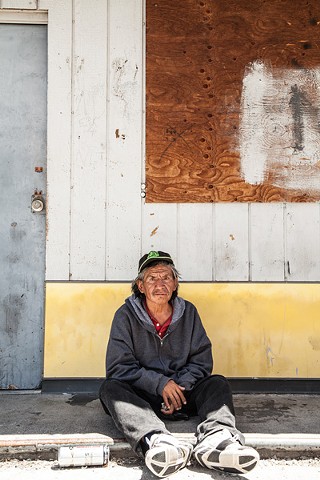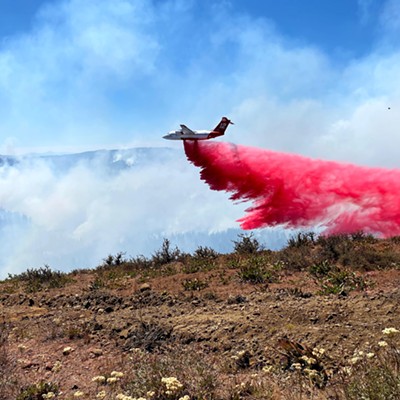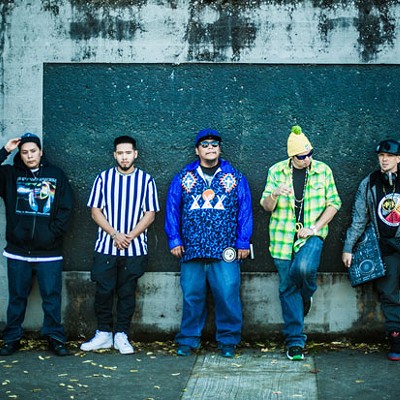Warm Springs is in trouble.
The signs are easy enough to miss. From the curving canyon road hugging the twists and turns of the Deschutes to the desolately dramatic outcroppings flanking either side, the barren beauty provides a welcome distraction from creeping realities. Even the human-built structures there evoke majestic natural and historical elements—Indian Head Casino resembles the historic fishing scaffolds at Celilo Falls—and even the small details, like the signs for the 1970s lodge at Kah-Nee-Ta, have a certain retro charm.
But turn off the main drag, and head down a side street and the grip of persistent poverty is instant: abandoned buildings with boarded up windows and government signs with more letters missing than remaining.
While many Native American tribes are struggling, Warm Springs is particularly hard hit—70 percent of tribal members are unemployed, and nearly half are living in poverty. These numbers are seven and two times as high as those for Jefferson County, respectively, a county that is is not economically strong.
And though the Confederated Tribes of Warm Springs has a number of economic ventures under its belt, none are doing particularly well. Urbana Ross, an assistant planner for Warm Springs and former chief operations officer, says that while the tribe was never well off, it managed to sustain for many years. But recently, even those opportunities began to sour.
"It's become more drastic these last three years," Ross says. She attributes the tough times to a decrease in revenues from the local timber and hydropower industries—both of which had been staples for the local economy. Moreover, the high cost associated with building the Indian Head Casino in 2012, and a steady population growth has further pinched the local economy.
And now, over the past two years, the tribal government has been pushing another major project with the glittering promise of more jobs and increased revenue flow. But that idea—to place a massive motor sports park, a quarter-billion dollar project complete with a race car track and drag strip—has split public opinion in Warm Springs and, moreover, is exposing deep-seated cracks in the reservation's already shaky economic future.
Last Wednesday, on July 2, tribal members voted on a referendum to launch an exploratory process into bringing that major development and, potentially, hundreds of jobs. It was the third time that tribal members had been asked to vote on the motor sports referendum. The previous two times, the results were invalid because the required one-third of eligible voters failed to turn out. And, last Wednesday, once again, the referendum failed to meet the required participation level. Of those who voted, though, a slight majority opposed the referendum (429 to 389).
Two days after the vote, I walked through Warm Springs, asking local residents how they felt about the proposed motor sports park—and, whether they voted or not, most did not favor the park.
I approached two older men standing by a flagpole outside the post office, across from the Warm Springs Market. As community members pass by to get their mail, the two men distribute handshakes, head nods and the occasional greeting: "Picking up your bonus check?"
The man on the left says he didn't vote on the motor sports park referendum, but his friend has plenty to say about the issue. He didn't vote either, but not for lack of interest. He's Lakota, and not a member of one of the three Confederated Tribes of Warm Springs—the Warm Springs, the Wasco and the Paiute—so he doesn't have voting rights. But as the husband of a tribal member and a 50-year resident of Warm Springs, he has some strong opinions. Neither of the men is willing to give his name.
"People voted against it because it's too close to the watershed," he says. "There are a lot of Indian foods that grow there." He adds, "there's a lot of game out there."
The proposed motor sports park was slated to be built on a 1,000-acre site at Miller Flat, a plain west of Highway 26, south of Mill Creek and about 2,700 feet in elevation that is a popular grazing ground for elk that locals hunt.
In exchange for the use of that valued land, the company behind the motor sports park, Lionshead Development, promised jobs and economic development. Jeff Anspach, chief operations officer for Warm Springs Ventures, didn't reply to a request for comment before press time, but last year told the Madras Pioneer that the project would create an estimated 425 development-phase jobs, 200 jobs for operations and an additional 225 through supporting businesses.
But that exchange—handing over land, likely through a long-term lease agreement—is what is unsettling to many residents. Environmental and natural resource concerns aside, some feel as if giving non-tribal members de facto control of tribal lands is contradictory to the treaty that protects the reservation.
Where the tribes once occupied about 100 million acres across the better part of the state's northeastern quadrant, including what is now Bend, the 1855 Treaty of the Middle Bands of Oregon consolidated their sovereignty to a small tract of land of 644,000 acres straddling the Deschutes, and its dramatic canyon walls.
Since its official incorporation in 1938, the Confederated Tribes of Warm Springs has gradually sought ownership of all the income-generating entities on the reservation, including the Kah-Nee-Ta hot springs (1961) and the former Jefferson Plywood Company mill (1967), and is working toward 51 percent ownership of Pelton Dam (the tribe assumed one-third ownership in 2002). To many, ceding land to an outside development company in exchange for uncertain economic benefits and potential ecological harm seems counterproductive to the trend of regaining control.
"What if it tanks?" asks Alyssa Macy, a tribal member and media consultant who recently returned to Warm Springs after living in New York and Chicago. "You can't reclaim that land once you put that much pavement on it."
Macy has given the referendum considerable thought. In fact, when it came up for a vote for the second time last July, she supported the measure. Over the next year she began researching and asking questions, but she didn't get the answers she was looking for. Like so many others, she was concerned about the project's footprint—that it would stomp out vital natural resources—and began to lose faith that it would balance the community's cultural and economic needs.
"That really, for me, became the stickler on my decision," Ross says. "I see the need for economic development, but the reality is there are not a lot of small businesses in this community that would benefit from this."
This time around, Macy opted to express her growing opposition by not voting. Unlike the rest of Oregon, Warm Springs votes in person instead of by mail, and she felt that not showing up made a stronger statement than simply voting no.
"I made the decision to not vote," Macy explains. "I think the reason [tribal members didn't vote] is that we just didn't want to see it be valid. People voted with their feet by not showing up."
Even supporters of the referendum had their doubts. Outside the Warm Springs Market, a man with short hair covered by a do-rag and groceries tucked into his arm, stopped in the middle of the street to talk with me.
"I voted 'yes,'" he says, adding, "Everyone told me to vote 'no.'"
He says people advised him post-vote that the park would disturb traditional elk hunting. But he voted for the referendum, he says, because he was told it would bring more jobs.
For some, the prospect of additional employment opportunities outweighed the potential harm.
Outside the Warm Springs Health and Wellness Center, residents flowed in and out of the modern and artfully constructed building en route to appointments or work. One of them, a tall man with long, flowing hair, says he thought the motor sports park was worth the risk.
"It's not an ideal plan," he says, "but given our situation, it would have helped."
No one questions that the situation—the tribe's dwindling ability to support itself—needs fixing. It's the solution that tribal members are struggling to agree on.
How did things get so bad?
The short answer: Tribal spending is outpacing income. The Warms Springs 2011 annual financial report (the most recent one available online) provides a clear forecast of today's economic woes. The report, which describes the tribe's economic situation as "tenuous," shows climbing costs and shrinking revenues.
Take, for example, the timber industry. Long a major contributor to the Warm Springs economy, Warm Springs Forest Products Industries (WSPI), according to the report, saw a decrease in net assets of more than $1 million in 2011. Another major tribal industry, hydropower, has also been a decreasing contributor to the local economy as the cost of energy goes down. From 2008 to 2011, the price of hydropower went from $58 per kilowatt to $28 per kilowatt.
These two industries are no longer able to hold up the Warm Springs economy, but Warm Springs Composite Products—a producer of composite ballistics materials and door components—is at least holding its own, maintaining profitability through tough economic times due to a strong showing in the international market. Its tight-grain Douglas Fir products are apparently rather popular in Japan.
Even so, its seems as if the economy is moving, at best, one step forward and two steps backward. To remedy the sagging timber and hydropower revenues, tribal leaders did what many other tribes have done: They opened a casino. Or rather, they built a new one in a more high profile location, closing the casino added on to the Kah-Nee-Ta lodge in 1995. Casinos have been a popular revenue generator since the Supreme Court ruled in 1976 that states don't have the authority to regulate the activities of Indian reservations. Today, about 43 percent of all tribes run one or more casinos. And while some tribes' casinos have seen massive profits, for Warm Springs, that golden goose doesn't seem to be laying enough eggs.
Actual revenues since the casino moved from Kah-Nee-Ta to Highway 26 near the Warm Springs Museum in 2012 are unclear. But when the project was launched, tribal leaders said they anticipated annual revenues of $9 million to $12 million. Yet, even if the new casino can generate that level of revenue, it may not be enough.
Over the past decade, tribal revenues have steadily declined, while spending consistently bumped up. In 2002, the tribe's enterprises brought in nearly $10 million, according to the 2011 annual financial report. But, in 2011, they received just $3 million. And yet, the tribe distributes about $12 million to its members each year in the form of per capita, dividends, assistance to seniors and scholarships. It also provides subsidies to programs that serve its members including the Museum at Warm Springs, High Lookee Lodge (an assisted living facility), Warm Springs Forest Products Industries and Place for Kids.
As a result, over the decade from 2001 to 2011, the tribe saw its coffers decrease by about one-third, from $77.3 million to $53.2 million. The report's authors anticipated an additional decrease in 2012 of somewhere between $14 million to $17 million, and had a more dismal prediction for 2013, expressing doubt that the tribe would be able to sustain its current level of operations under those conditions. Stated most simply: In 2011, the tribe spent nearly $13 million more than it brought in—and more than the anticipated profit at Indian Head Casino.
Moreover, by the time the casino arrived, it already had saddled the tribe with debt: a decade's worth of efforts to build a casino outside the reservation in the Columbia Gorge—a move that faced strong opposition from Gov. John Kitzhaber and environmental groups—racked up a hefty tab. By the time the tribe called off its pursuit of the Gorge location, the tribe had sunk nearly $30 million into the project.
In spite of these sinking economics, in 2011 the tribal government continued to hand out a total of $3.8 million in bonuses to tribal members, and disbursed an additional $6 million in per capita payments, the funds paid out to individual tribal members from casino and other profits.
What's a tribe to do?
In an effort to cut costs, the tribal government recently cut back per capita payments from $100 a month to $25. But Alyssa Macy, the media consultant, says the payments should be eliminated completely and that annual bonus payments—ideally disbursed following a financially successful year—should have stopped 10 years ago.
Members of the tribal government, including tribal council and Secretary Treasurer (the equivalent of CEO) Jake Suppah did not respond to a request for comment by press time.
Macy adds that while she doesn't have answers to Warm Springs' financial problems, she believes the path forward will be through community engagement and support for small business, not the introduction of a large-scale project. But first, she says, the community needs to heal from the distrust created by previous government actions.
"We are struggling financially as a tribe as a result of decisions made by past leadership due to expenditures," Macy says. One of those was the Gorge casino initiative. "I think what needs to happen is we need to move from a culture of pointing fingers and being upset about decisions of the past and come together to make decisions as a community...and that's really tough."
Macy, who has advocated for the rights of Indigenous peoples within the United Nations and currently serves on the Global Coordinating Committee for the 2014 World Conference on Indigenous Peoples, adds that while she's not aware of any broad-reaching political organizing on the reservation, people are starting to become vocal about their concerns.
She says she hopes that those community conversations will include discussions about the basic framework and foundations of tribal government as well as the treaty document.
"We have to get back to the basics about what it means to be sovereign, what does it look like on a daily basis," Macy explains. "To me, some of the basic tenants are that we take care of our own people, that we respect the land that we have."
That's where support for small business comes in. She says that as an independent consultant, she sees the potential benefits first hand. The money she makes is not filtered through any other entity, and she is able to spend much of that income locally.
"It creates that revolving economy in our own community," she says.
Not only would investing in small business strengthen the local economy from the ground up, Macy says, it may be the only option.
"We're in a situation where we do not have the capital to make significant investments. We're not going to turn Kah-Nee-Ta into Great Wolf Lodge; we don't have money," she says. "Where you do get some opportunities is with small strategic investments."
While big projects like the motor sports park may promise to bring hundreds of jobs, Macy says it's important to see past the number of positions. She says the park jobs would likely be seasonal, low paying and not guaranteed to go to tribal members as Warm Springs has no tribal employment preference code.
As it stands, both Macy and Warm Springs planner Urbana Ross say that the reservation has a number of open, unfilled positions. There simply aren't enough qualified people. Supporting small businesses through micro lending programs or special enterprise zones, on the other hand, would empower the tribal members to make a living doing work for which they have skills and interest.
As an example, Macy points to Little Leaf Guide Service, a local company that provides fishing and hunting tours and is doing well. The husband and wife-run business received some non-tribal business loans to cover overhead costs and then ran with it.
"I think people would open more businesses if they had support," she says. "Sometimes you just need a little injection of money to get things going."
When it comes to tourism, a popular approach for Oregon tribes, Macy says she thinks smaller scale, culturally sensitive projects would fare better. While the relative remoteness of the Warm Springs reservation makes it harder to cash in on drive-through tourism dollars, that same quality could attract visitors interested in exploring a lesser-known area.
To that end, Macy daydreams of a series of single-track trails for cyclists or a cultural tourism program like one she worked on while living in Wisconsin. There, a band of the Ojibwe tribe created audio tours—currently on CD, but likely moving to a smart phone app in the future—that guide visitors through the local history, with accompanying road markers. These kinds of efforts, Macy says, highlight tribes' history and traditions instead of standing in opposition to them.































